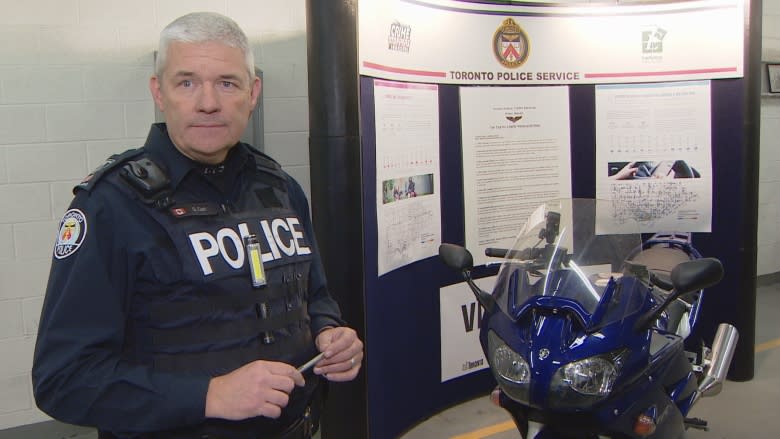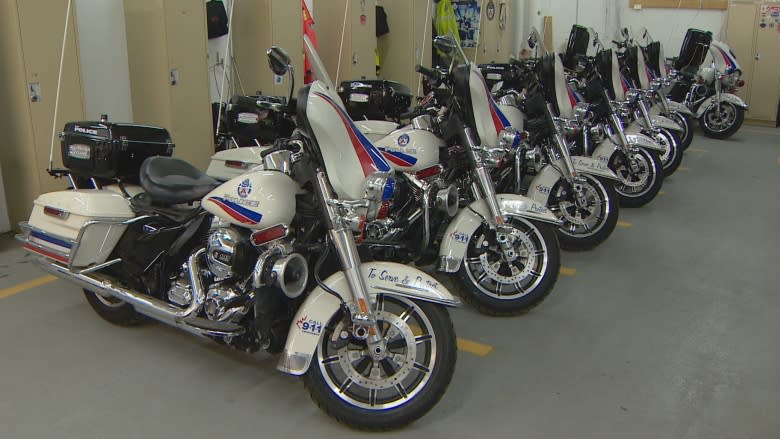Police urge motorcycle, bike riders to think safety before hitting the open road
Toronto police are rolling out safety tips this week for motorcycle riders and cyclists this week hoping to reduce injuries and deaths on city streets.
Const. George Carl, spokesperson for Toronto Police Service's Traffic Services, said police are hoping that riders take note before hitting the open road.
Motorcycle and Bicycle Safety Week has been scheduled to coincide with the start of the riding season, he said on Monday.
"It's basically geared to avoid some of the early season accidents and injuries that we've been seeing in years past," he said.
"We want to get people thinking about safety, to get people thinking about proper equipment, to get people thinking about checking their vehicles, both bicycles and motorcycles, to make sure they're ready for the road."
Since 1995, Toronto has had 78 motorcyclist deaths. Since 2003, 32 cyclists have died in the city.
The 25-to-39 age group has the highest number of motorcycle deaths since 1995, accounting for 46 of the 78 fatalities.
Carl said, however, police in Canada and the U.S. are seeing an increase in motorcycle fatalities among people aged 45 to 55.
"Perhaps they're at a stage in their life now where they can afford a motorcycle and they've gone for many years without one, but perhaps the last time they rode a motorcycle was when they got their licence, maybe in the early 70s or early 80s," he said.
"Now they're in their 40s and 50s and they're buying that 800- or 900-pound touring bike. They haven't taken a training course. They haven't upgraded their skills, the technology has changed, the motorcycle is more powerful and they're getting themselves into problems and getting themselves hurt," he said.
Practise in an empty parking lot
Of all the 78 motorcycle fatalities from 1995 to 2017, all the victims were male. There was no pattern to indicate where the crashes were occurring the most, most of the deaths occurred when the weather was dry and the time of the fatal crashes was varied.
Carl suggested that motorcyclists practise handling their bikes, including braking skills, in an empty parking lot before getting out into traffic.
"What we see with a lot of riders is sometimes they are a little too eager to get out there on the bike. They tend to use a little too much speed before they get used to the machine," he said.
"We see accidents that occur that involve too much speed for the conditions, too much speed for their training, motorcycles taking curves at a speed that is too high and they don't negotiate their speed properly, and sometimes speed that is too high for the traffic and they don't have time to react to what other drivers do."
Wear the right clothing for the vehicle
Police urge motorcyclists to:
- inspect front and rear tires.
- make sure the tread is at the proper level.
- check tire pressure.
- invest in protective clothing, including boots, jacket with "armour" at the elbows, and "armoured" pants.
- wear a good helmet that fits properly and offers good vision.
"You have to have your body protected," Carl said.
Police urge bicyclists to:
- wear clothing that will not catch in the wheels or chain.
- wear an approved helmet for safety.
- check front and back lights.
- add a reflective light.
- if riding at night, wear light-coloured clothing or reflective fabric that glows in the dark.
- use bicycle lights from a half hour before sunset to a half hour after sunrise, and use a white front light and a rear red light or reflector.
- avoid puddles in case there are hidden hazards, such as potholes and glass.
Cyclists 14 and over are not legally allowed to cycle on Toronto's sidewalks.
Use bell or horn to avoid being doored
Const. Jenifferjit Sidhu said it makes sense for cyclists who have not been biking all winter to take a few precautions before going out for the first time.
"Whenever you are taking your bicycle out on the road, always make sure the lights are working, both the front and the rear," Sidhu said.
"As well you can also have a reflective light, which is something you can have to make sure you are more visible and seen when you're out on the roadway."
In a news release, police said to help reduce the chances of being doored, cyclists should use a bell or horn when nearing vehicles with occupants, leave a metre between your bike and parked vehicles, and have an escape route in case a door is opened by a driver or passenger.
Police also said that due primarily to driver error in designated bicycle lanes, drivers are often making right turns improperly and are crashing into cyclists.
They said although responsibility in most cases falls to the driver, cyclists are urged to use caution when nearing intersections to ensure a safe commute.





